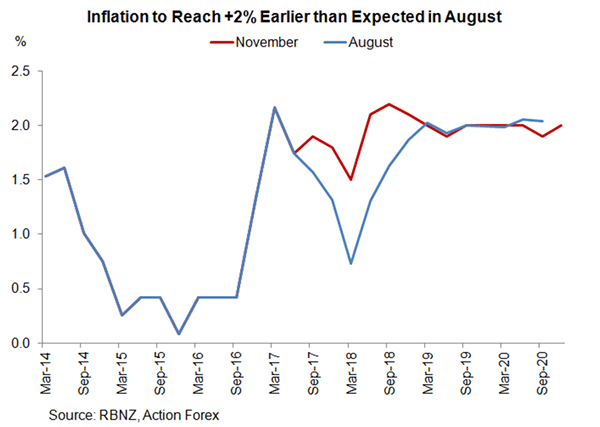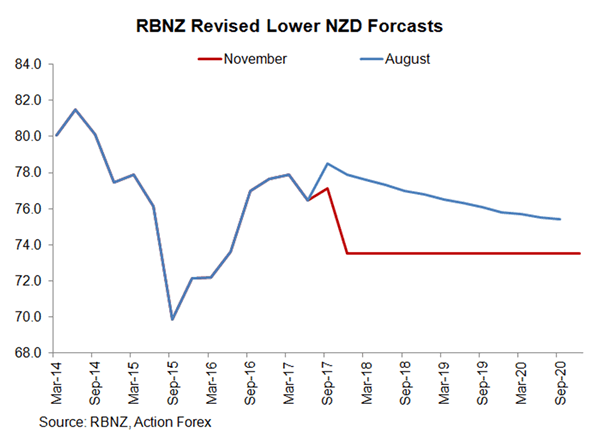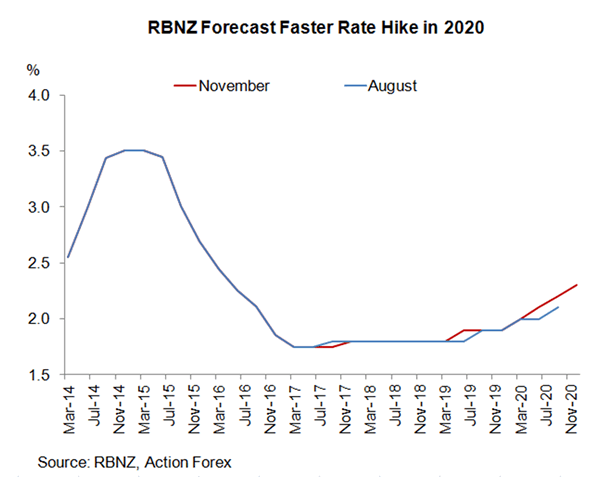While keeping the OCR unchanged at 1.75%, the tone of November RBNZ statement has turned slightly more hawkish than previous ones. The central bank upgraded inflation forecasts, while describing core inflation as ‘subdued’ and reiterating ‘uncertainties’ in the new government’s policies. The growth outlook remained largely unchanged from August’s, as weaker growth in the housing and construction sector would be offset by greater fiscal spending promised by the new government and higher terms of trade, thanks to NZD depreciation and the rise in oil prices. RBNZ slightly pushed ahead the rate hike schedule. However, given the minimal change, we believe this is rather a symbolic move. The central bank expects more material interest rate movements by 2020. We believe the monetary policy would stay unchanged for the rest of 2018.
Macroeconomic Outlook
The tweaks in the accompanying statement evidenced the growing optimism in the economic outlook. As noted in the statement, ’employment growth has been strong and GDP growth is projected to strengthen, with a weaker outlook for housing and construction offset by accommodative monetary policy, the continued high terms of trade, and increased fiscal stimulus’. This was compared with August’s statement that ‘while exports recovered, construction was weaker than expected’ and ‘growth is projected to maintain its current pace going forward’, supported by ‘accommodative monetary policy, population growth, elevated terms of trade, and fiscal stimulus’. In the November statement, RBNZ indicated that strong growth is evidence of strong economic developments while GDP growth should strengthen further. The central bank this month included terms of trade as a factor supporting growth.
RBNZ elaborated its view over the weakness in housing market, adding ‘reduced foreign demand’ to the number of reasons causing moderation in housing market prices. It added that low house price inflation would continue as ‘reinforced by new government policies on housing. The central bank this month appeared to have shrugged off the risk ‘of resurgence in prices given population growth and resource constraints in the construction sector’.
The tone on inflation apparently turned more hawkish. While acknowledging ‘subdued ‘core inflation and ‘moderate’ non-tradables inflation, the central bank forecast the latter would ‘increase gradually as capacity pressures increase’. It also noted that ‘tradables inflation has increased due to the lower New Zealand dollar and higher oil prices’. It forecast inflation ‘to remain near the midpoint of the target range and longer-term inflation expectations are well anchored at +2%’. In August, the statement suggested that headline inflation would approach ‘the midpoint of the target range over the medium term’ while ‘longer-term inflation expectations remain well anchored at around +2%’. RBNZ has pushed forward the timeline of achieving the +2% inflation target by nine months.

New Government
The November statement talked about the new government, suggesting that the central bank’s estimates have incorporated the impact of new government policies in new government spending, KiwiBuild programme, tighter visa requirements and increases in the minimum wage. RBNZ added that the impact of these policies is ‘very uncertain’. Interestingly, Acting governor Grant Spencer appeared very optimistic over these policies, expecting them to add about +50 bps to GDP growth in the RBNZ’s assessment.
NZD
The central bank appeared less concerned about the exchange. It noted that kiwi ‘has eased since the August Statement and, if sustained, will increase tradables inflation and promote more balanced growth’. Indeed, NZDUSD has fallen around -5% since the August meeting, mainly due to the election uncertainties and the final outcome.

OCR Change
The language on the monetary policy was exactly the same as the August one. However, we notice modest upticks in the rate hike forecasts for June and September 2019, by +0.1 percentage point to 2.1% and +2.2% respectively. While the increase was very mild, this shows that RBNZ has turned more upbeat about the economic outlook.













